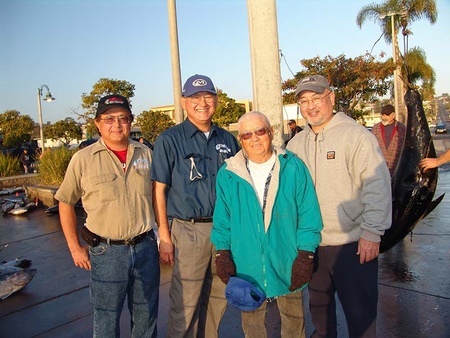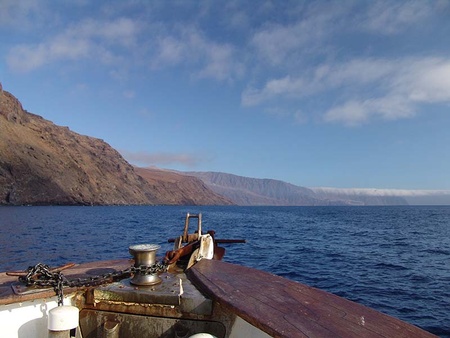Have you ever read Ernest Hemingway’s famous novella: “The Old Man and the Sea”? It is a tale of stamina and survival in which Santiago, an old, unlucky Cuban fisherman attempts his last catch in the Gulf of Mexico. He lands a gigantic marlin, but despite all efforts, what he brings home is only the skeleton. A pack of sharks that nearly did him in too, ate his gorgeous catch.
Had Hemingway met Beans Sogioka in January 2006, when Beans was already 86, he might have developed the story differently.

The best tuna Beans got was a 239-pounder--not bad for an 86-year-old (Photo courtesy of Bill Roecker, Fishing Videos)
On January 6, to be exact, Beans landed six gigantic tuna, two-hundred or more pounds each, during a twenty-three day fishing sally which went all the way to Clipperton Island, in the Pacific. The Leisure Club and many of us ended up with sashimi by the kilo; Beans with five-hundred tins of canned tuna, which he has steadily shared with friends and community projects.
After that great adventure, one afternoon at the Leisure Club Beans solemnly announced: “That’s the end of sashimi. No more fishing...I’m definitely retiring. Getting too old!” It felt like a eulogy. Can you imagine no more sashimi coming from the Sogioka after more than fifty years?
It is now May 2007. Beans suddenly announces that in August he’s going back to deep sea fishing. All of us, the entire Leisure Club, exploded with cheers. We were already drooling at the coming goodies that would result from that trip.
That is Beans Sogioka one of the two surviving members of the “Anglers’ Club,” and quite a colorful member among our most respected Founders.
“Why ‘Beans’,” I asked; perhaps the 1,000,003rd insensitive person with the same idiotic question. He didn’t even wince.
“I always hated my Nihongo name ‘Mitsu…yoshi.’ When I was in Third Grade my friends called me ‘Beans’ ‘cause I was a short kid… so the name stuck.”
“Micha-n,” I countered, “like my brother-in-law; sounds very nice.”
“Too Japanesey…”
And I understood quite well. In those days, being of Japanese descent did not set too well with many other Americans.
Beans was born in Baldwin Park in 1919. His parents had come originally from Hiroshima. California law, then, prevented Japanese immigrants from acquiring land; so like many other Issei, the Sogioka too were tenant farmers. Despite the restrictions, the tenants were quite successful. Almost every foot of land in this part of the Valley was citrus groves.
“We knew the area quite well. Every Nissei kid had his own bike, which made hakujin kids jealous, because their families couldn’t afford one. I attended Grammar school at Baldwin Park, and graduated from Covina High School. Was happy to have been drafted in March 1941, believing I’d serve my mandatory one-year, and then ‘Sayonara!’ to the Army.”
But WWII messed up Beans’ intended “sayonara.” Instead, he had to dole out nearly five years as an Army medic, which saved him from concentration camps. During that period, while serving in an Army Hospital’s ward, he met a few prisoners from Iwo Jima. They were very surprised when he spoke Japanese to them.
“They were really yaban…rural kids who knew nothing about America; but we became good friends. First we exchanged family stories. Then they learned a lot about America. And after the war ended, they were sent back to Japan.”
The rest of the Sogioka family were interned at Heart Mountain, along with other Baldwin Park residents. Soon after internment, his brother Yosh, and other young Niseis accepted the government’s “invitation” to go to Montana and help the sugar beet farmers.
“First thing the group found at Powell and Harding, Montana were signs that read: ‘No Japs(sic) Allowed.’ Despite that, they worked like demons, and the farmer was astonished about their excellent work. Soon, other growers came to ask: ‘Hurry up, hurry up, and come and help me get my crop!’… The unwelcome sign was soon a thing of the past. Everybody wanted to have Japanese workers in their fields. Do you know Bill Hosokawa’s book, ‘The Quiet American?’ Yosh’s picture is there. (Page 341).”
Beans was allowed to visit his family at camp, and there is where he met Lucy, his wife, then just a kid. In those days GI’s didn’t care too much for 16-year girls. Yet, Lucy must have impressed him quite a lot, because 5 years later, when she was 21, they got married.
As the end of WWII approached, now released from concentration camps, the Sogioka family, and many of the old Baldwin Park residents managed to return to the area, and to gradual success. Beans’ father acquired a large tract of property as payment for a debt. After forty years of successfully managing the land, now highly appreciated in value he sold to a school district for many times its original cost.
“Yosh and a couple of friends1 started this place; and many of its highlights: the Judo Dojo; later the Kendo Dojo; the Anglers’ Club; the memorial plaques… you name it. We were involved since Day One.”

Bruce, Norm, Beans and Don Sogioka are all keen on fishing (Photo courtesy of Bill Roecker, Fishing Videos)
The Center, then the East San Gabriel Valley Japanese American Association was at a tract at Sunset and Service, by the Big Dalton Wash.2 It offered Gakuen; church services; Judo; and a few other activities; it was always busy with barbeques and fundraisers; but lacked “domestic” drinking water. So the founders and their buddies dug a well, whose walls they reinforced inch by inch with concrete. The well served until the area joined the regular water service. The Association lost the tract in an “eminent domain” process involving the City of West Covina. Next it acquired the current property and changed its name to The East San Gabriel Valley Japanese Community Center. Yosh and his wife kept serving until their recent deaths. Beans and Lucy are still there.
“I know I’m monkutare…but I cannot see a thing that needs fixing, without the urge to fix it. I’m a doer. Not so much now, because I feel really old…not enough pep.”
Oh, really? That depends a lot on personal interpretation. Even now, Beans always carries in his vehicle a little tool kit with all sorts of “thingies,” for items that need his expertise at tinkering, and his dedication.
And, where is that Clipperton Island where the big tuna catch of 2006 happened? It’s a 9 square mile, ring-shaped, arid and volcanic atoll almost 1,200 miles southwest of Long Beach. The island’s stagnant lagoon, polluted with sulphuric acid, cannot support any animal life. Why Mexico and France disputed its ownership for years is a mystery. In the 1930’s France won it. During WWII, the US Navy “occupied” the island for a super secret project, but it abandoned the project after 1945. The place, now uninhabited, is occasionally visited by anglers. The surrounding area is rich in tuna, shark and manta. And there is where Beans landed his catch of over 1,200 pounds of future sashimi.
Beans had to set foot on the wretched place. Of course! He found it covered with “millions of empty Japanese whiskey and sake bottles...” and he speculated if some contained “secret messages.” But that’s Chapter One for another story.
Notes:
1. Kim Hatakeyama and Frank Konno.
2. It had been deeded by Nobuo Sera and Chiye Hashimoto Taniguchi.
*This story first appeared in the East San Gabriel Valley’s Japanese Community Center’s “Newsette” in September 2007.
© 2007 Edward Moreno







